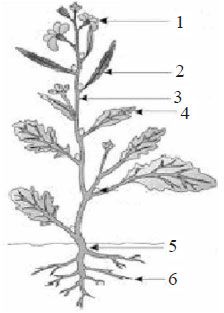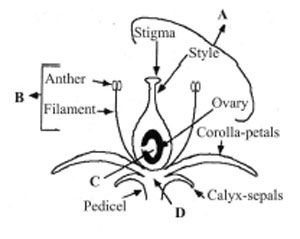Roots develop from parts of the plant other than radicle are called
tap roots
fibrous roots
adventitious roots
nodular roots
Correct Answer :
C. adventitious roots
Root developing from any part of the plant other than the radicle is called adventions roots. Adventitious roots are found in some plants like grass, Monstera and the banyan tree.
Related Questions
Ginger is an underground stem. It is distinguished from root because
it lacks chlorophyll.
it stores food.
it has nodes and internodes.
it has xylem and vessels.
The given figure shows the region of root tips with their region marked as A, B and C. Choose the option which shows the correct labelling of A, B and C.

A - Zone of elongation, B - Zone of meiosis, C - Zone of mitosis.
A - Zone of maturation, B - Zone of meristematic activity, C - Zone of elongation.
A - Zone of mitosis, B - Zone of elongation, C - Zone of root cap.
A - Region of maturation, B - Region of elongation, C - Zone of meristematic activity.
Pneumatophores are found in
the vegetation which is found in marshy and saline lake.
the vegetation which found in saline soil.
xerophytic condition.
hydrophytic condition.
Consider the following statements regarding the root system of angiosperms and choose the correct option given below.
- In monocots, the fibrous root system arises from the base of the stem.
- The region of elongation is called the root hair region.
- In sweet potato, the adventitious roots get swollen and store food.
- The stems of maize and sugarcane have supporting roots called prop roots.
(i) and (ii) are correct but (iii) and (iv) are wrong.
(ii) and (iii) are correct but (i) and (iv) are wrong.
(ii) and (iv) are correct but (i) and (iii) are wrong.
(i) and (iii) are correct but (ii) and (iv) are wrong.
A scar on the seed coat through which the developing seeds attached to the fruit is called as ________.
testa
tegmen
hilum
micropyle
The given figure shows the parts of flowering plant. Which parts of the given figure were involved in the following functions:
- Storing reserve food material
- Synthesis of plant growth regulators.
- Absorption of water and minerals from the soil.
- Providing a proper anchorage to the plant parts

5 and 6
1, 2 and 6
1, 2, 3 and 4
2, 4, 5 and 6
Which one of the following option shows the correct labelling of the structure marked as A, B, C & D?

A - Gynoecium, B - Megasporophyll, C - Ovule, D - Thalamus
A - Gynoecium, B - Stamen, C - Seed, D - Thalamus
A - Microsporophyll, B - Stamen, C - Ovule, D - Thalamus
A - Gynoecium, B - Stamen, C - Ovule, D - Thalamus
The main purpose of phyllotaxy for the leaves is to provide sufficient_______.
soil
air
water
light
Stilt roots occur in __________ .
groundnut
rice
sugarcane
wheat
Match column I with column II and choose the correct combination from the options given below.
| (Position of floral parts on thalamus) | (Represented in) |
|---|---|
| A. Hypogynous | I. Ray florets of sunflower |
| B. Perigynous | II. Brinjal |
| C Epigynous | III Peach |
A II, B I, C III
A I, B II, C III
A III, B II, C I
A II, B III, C I
It is a proteinous layer and the outer covering of endosperm which separates the embryo. Identify the layer.
Tegmen
Scutellum
Hyaline layer
Aleurone layer
Most prominent function of inflorescence is
dispersal of seeds.
formation of more fruits.
formation of pollen grains.
dispersal of pollens.
Which of the following is not the characteristic features of fabaceae?
Tap root system, compound leaves and raceme inflorescence.
Flowers actinomorphic, twisted aestivation and gamopetalous.
Stamens 10, introrse, basifixed, dithecous.
Monocarpellary, ovary superior and bent stigma.
The main function(s) of root system is/are
absorption of water and minerals from the soil
storing reserve food material
synthesis of plant growth regulators
All of the above
Study the following statements and select the correct option
- Buds are present in axil of leaflets of the compound leaf.
- Pulvinus leaf-base is present in some leguminous plants.
- In Alstonia, the petioles expand, become green and synthesize food.
- Opposite phyllotaxy is seen in guava.
(ii) and (iv) are correct but (i) and (iii) are incorrect.
(i) and (iii) are correct but (ii) and (iv) are incorrect.
(i) and (iv) are correct but (ii) and (iii) are incorrect.
(ii), (iii) and (iv) are correct but (i) is incorrect.
Which one of the following characteristics is not related to gynoecium?
It is the female reproductive part of the flower.
It is composed of stamens.
Stigma is usually at the tip of the style and is the receptive surface for pollen grains.
Each ovary bears one or more ovules attached to a flattened, cushion like placenta.
Roots develop from parts of the plant other than radicle are called
tap roots
fibrous roots
adventitious roots
nodular roots
Match the column I with column II and choose the option which shows their correct match.
| Column I | Column II |
|---|---|
| A. Placentation | (i) Arrangement of flowers on the rachis |
| B. Aestivation | (ii) Modified shoot for sexual reproduction |
| C. Inflorescence | (iii) Arrangement of various whorls in the bud |
| D. Flower | (iv) Arrangement of ovules within an ovary |
A - (i), B - (ii), C - (iii), D - (iv)
A - (iii), B - (i), C - (ii), D - (iv)
A - (iii), B - (i), C - (iv), D - (ii)
A - (iv), B - (iii), C - (i), D - (ii)
The X is small and situated in a groove at one end of the endosperm. It consists of one large and shield shaped cotyledon known as Y and a short axis with a plumule and a Z. Identify X, Y and Z.
X - Scutellum, Y - Embryo, Z - Radicle
X - Embryo, Y - Scutellum, Z - Radicle
X - Scutellum, Y - Radicle, Z - Embryo
X - Radicle, Y - Embryo, Z - Scutellum
In which of the following plants, a slender lateral branch arises from the base of the main axis and after growing aerially arch downwards to touch the ground?
Mint and jasmine
Banana and pineapple
Grass and stawberry
Pistia and Eichhornia
Which of the following statement(s) is/are correct about calyx?
Calyx is the outermost whorl of the flower and are called sepals.
Sepals are green, leaf like and protect the flower in the bud stage.
The calyx may be gamosepalous (sepals free) or polysepalous (sepals united).
Both (a) and (b)
The character of flower which is represented by floral formula but not by floral diagram is
aestivation
placentation
position of gynoecium
adhesion of stamen
The given figure shows a typical structure of monocotyledonous seeds. Identify A, B, C, D and E parts marked in the given figures.

A - Endosperm, B - Embryo, C - Scutellum, D - Coleorhiza, E - Coleoptile
A- Embryo, B - Endosperm, C - Scutellum, D - Coleoptile, E - Coleorhiza
A - Endosperm, B - Embryo, C - Scutellum, D - Coleoptile, E - Coleorhiza
A - Embryo, B - Endosperm, C - Scutellum, D - Coleorhiza, E - Coleoptile
How many plants in the list given below have marginal placentation?
- Mustard
- Gram
- Tulip
- Asparagus
- Arhar
- Sunhemp
- Chilli
- Colchicine
- Onion
- Moong
- Pea
- Tobacco
- Lupin
Four
Five
Six
Three
Which of the following statements is correct?
Imbricate aestivation is found in papilionaceous family.
Generally sepals are green, leaf like and protect the flowers in the bud stage.
In cymose type of inflorescence, the main axis terminates in a flower, hence is limitless in growth.
In axile placentation ovary is one chambered but it becomes two cambered due to formation of the false septum.
A branch in which each node bearing a rossette of leaves and a tuft of roots is found in aquatic plants like _________ and _________.
Hydrilla and Pistia
Eichhornia and Hydrilla
Pistia and Eichhornia
Pistia and Vallisneria
Which type of function is performed by the fleshy leaves of onion and garlic?
Storage
Reproduction
Photosynthesis
Protection
The region of the root-tip which is involved in the formation of root hairs by epidermal cells is called the
region of maturation.
region of meristematic activity.
region of elongation.
none of the above.
Which of the following statements are correct?
- From the region of elongation, some of the epidermal cells form root hairs.
- Pneumatophores are seen in Rhizophora.
- Adventitious roots are seen in the banyan tree.
- Maize and sugarcane have prop roots.
(i) and (iv)
(i), (iii) and (iv)
(iii) and (iv)
(ii) and (iii)
The part of the root which is most active in water absorption is called
root cap
maturation zone
meristematic zone
zone of elongation
